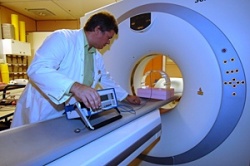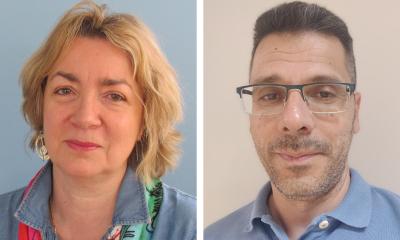New Study Shows Global Variation in Dose Levels for Child CT Scans
By Louise Potterton, IAEA Division of Public Information
An international study, conducted by the International Atomic Energy Agency (IAEA), has shown that some countries are over-exposing children to radiation when performing computed tomography (CT) scans. These children are receiving adult-sized radiation doses, although experts have warned against the practice for over a decade.

The IAEA´s study, which was carried out at 128 healthcare facilities in 28 developing countries in Africa, Asia and Eastern Europe, also found great variation in radiation levels and in the frequency of CT scans performed on children under 15 years of age.
IAEA Radiation Safety Specialist, Dr. Madan Rehani coordinated the study and said: "This study focused on children because they´re more sensitive to radiation and they have longer to live. So the use of adult parameters on a child when performing a CT scan means there´s an increased radiation dose and an increased risk of developing cancer in the long-term."
The study showed that 11 CT centres in six countries were using adult exposure parameters for paediatric patients. Dr. Rehani explained that such errors are normally due to the operator´s lack of awareness, but added that with CT scans it is difficult to detect higher exposures from the image itself.
"With these scans, if the exposure is too high the image does not deteriorate, in fact it tends to look better. This is in contrast to the conventional X-rays. If the exposure is slightly higher, the image goes black. So you know you´ve given a higher radiation dose than required."
This latest survey is part of the IAEA´s ongoing effort to improve awareness of radiation protection of patients around the world.
The medical application of ionizing radiation is the fastest growing source of radiation exposure to human beings today. "In many situations the benefits outweigh the risks," said Dr. Rehani, but he stressed that unnecessary radiation "needs to be avoided."
This X-ray based procedure, which provides three-dimensional views of organs or blood vessels, is a major advance in medical imaging and diagnosis. Yet, concern surrounds CT scans because they deliver relatively higher doses of radiation to patients in comparison to conventional X-rays.
According to the Director of the IAEA´s Radiation Transport & Waste Safety Division, Eliana Amaral, a recent workshop organised by the IAEA in cooperation with the European Commission found that unnecessary medical exposure in diagnostic radiology is common. "This could lead to an unnecessary radiation burden for people all over the world. Therefore, to maximize the benefits of these techniques, the doctors have to ensure that the procedure is justified," she said.
The recent study also found great variation in the levels of radiation used from region to region. There are international, regional and, in some cases, national diagnostic reference levels and the aim of the IAEA programmes is to detect whether the doses given to patients are within these levels.
According to Rehani, an additional problem in developing countries is that the available CT machines are older models without the automatic exposure controls found in modern equipment. This function can detect the thickness of the section of the patient´s body that is being scanned and can therefore optimise the level of radiation dose, avoiding unnecessary exposure.
"We also found in this study that sometimes the radiation output from CT machines was fine, but the patients were getting too much radiation because the operators scan larger parts of the patient´s body than necessary. So the operator´s skill is as important as the machine´s adjustment, so training and awareness-raising are essential," said Dr. Rehani.
In addition, the study showed that pediatric CT scans occur more frequently in Africa than in Asia and Eastern Europe. The frequency Rehani explained could be due to the limited availability of alternative medical imaging techniques, such as MRI and ultrasound, which do not involve ionizing radiation, or because some CT scans are performed unnecessarily.
However, the study also had some positive results. The 11 centres that were using adult CT exposure levels on children all reacted to the findings of the IAEA survey and are now addressing this issue.
"We informed the project counterparts in each country that the reports they sent us showed adults levels were being used on children and they reacted positively. The radiation doses are being reduced. So this is an ongoing process of increasing awareness about correct exposure factors," explained Dr. Rehani.
Recently the IAEA joined forces with Image Gently - a US-based campaign that was launched in 2008 by the Alliance for Radiation Safety in Paediatric Imaging amid concern over CT use in children.
The Chairperson of the Alliance, Marilyn J. Goske, said that "much has been accomplished" in the short time that the two organisations have been cooperating.
Ms. Goske, who is a Professor of Radiology at Cincinnati Children´s Hospital Medical Centre, added: "It´s clear that the mission of our two groups is strongly aligned. We´re both dedicated to radiation protection for patients and, in particular, children and we believe that informing parents about their child´s imaging studies and possible concerns regarding radiation is very important."
The IAEA´s Radiation Protection of Patients Unit is now establishing networks on radiation protection of children and has produced information not only for health professionals but also for patients that can also be found on the IAEA´s Radiation Protection of Patients (RPoP) website.
26.04.2010











